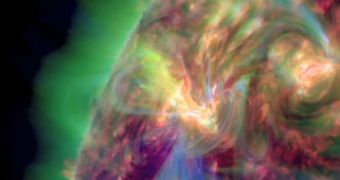At 04:13 UTC on March 5, 2012, the Sun released a very powerful solar flare, followed shortly by an impressive coronal mass ejection. The event was one of the strongest recorded recently, and experts classified it as a X1-class emission. This class contains the most intense solar events.
The Sun has been suspiciously quite over the past month or so, even though it's nearing a peak in its 11-year cycle. The solar maximum is scheduled to be achieved in 2012 or 2013, solar physicists explain.
During that interval, we can expect to see a large number of sunspots and CME being produced, some of which will be set on a collision course to Earth. Our magnetosphere will most likely protect us from the bulk of the radiations, and create amazing aurora displays in the process.
NASA is currently using several of its spacecraft, including the Solar Dynamics Observatory, to keep track of the charged particles that were released during the latest solar emission. It will then upgrade its threat estimate accordingly.

 14 DAY TRIAL //
14 DAY TRIAL //